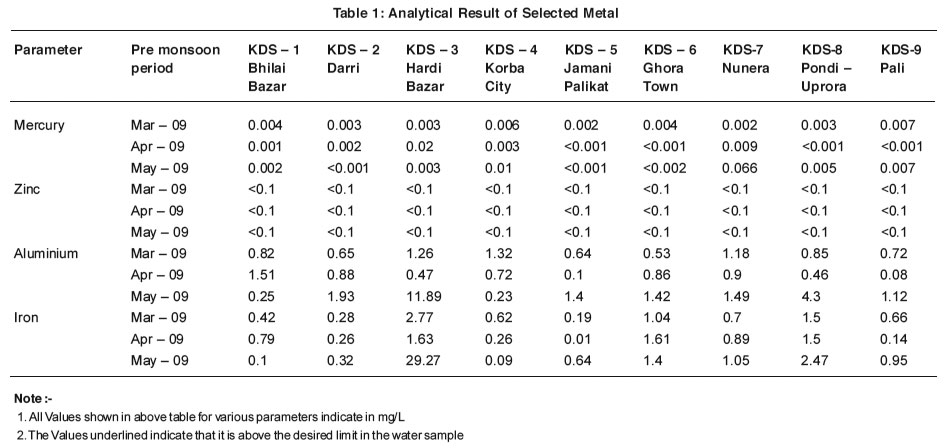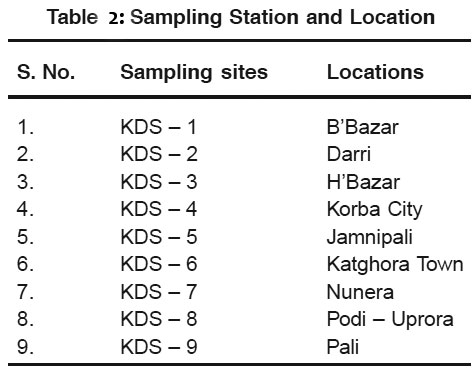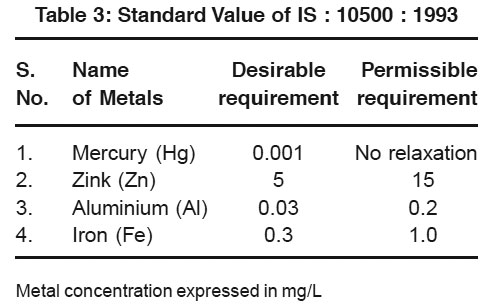Premonsoon assessment of heavy metals in surface aquatic system of Korba District, C.G
Ramesh Janjala1 * , Ashish Mishra1 and M.M. Vaishnav1
DOI: http://dx.doi.org/10.12944/CWE.5.1.34
Water is essential component of earth planet. The chief sources of water in the earth is surface and ground waster. Owing to anthropogenic activities natural waster sources are continue polluted. In this context, we have undertaken to the detection of concentration and presence of some selected heavy metals such as Hg, Zn, Al and Fe in different surface water, especially preferred open ponds in premonsoon season (March 2009 to April 2009). The measurement was done by ICPA method. The results are expressed in mg/L and values are compared with the standard value IS: 10500:1993, We have selected nine water sampling station in study are named from KDS-1 tO KDS – 9. The max concentration of Hg, Al and Fe were reported as 0.007, 11.89 and 29.27 mg/L at KDS – 9, KDS – 3 respectively in March – 2009 and May 2009. These values were exceed the permissible limit. Zn was detected below the permissible requirement at all water samples.
Copy the following to cite this article:
Janjal R, Mishra A, Vaishnav M. M. Premonsoon assessment of heavy metals in surface aquatic system of Korba District, C.G. Curr World Environ 2010;5(1):197- 200 DOI:http://dx.doi.org/10.12944/CWE.5.1.34
Copy the following to cite this URL:
Janjal R, Mishra A, Vaishnav M. M. Premonsoon assessment of heavy metals in surface aquatic system of Korba District, C.G. Curr World Environ 2010;5(1):197- 200. Available from: http://www.cwejournal.org/?p=1152
Download article (pdf)
Citation Manager
Publish History
Select type of program for download
| Endnote EndNote format (Mac & Win) | |
| Reference Manager Ris format (Win only) | |
| Procite Ris format (Win only) | |
| Medlars Format | |
| RefWorks Format RefWorks format (Mac & Win) | |
| BibTex Format BibTex format (Mac & Win) |
Article Publishing History
| Received: | 2009-12-10 |
|---|---|
| Accepted: | 2010-01-25 |
Introduction
Natural water resources are essential for the survive, existence and development of the human being. The main water sources are surface, grounds and rain water. Safe water, like air and food the primary need of flora and fauna system, without it any type life can’t sustained. In earlier time either waster sources ground and rain considered as the purest form of water. Now, due to large industrialization, over mining , anthropogenic activities uncontrolled population, in discriminated dumping of industrial and domestic wastes, improportion using of agrochemicals in cultivation, these water system: surface ground and rain became polluted and unfit for the human consumption. Only few sciectists have been done the assessment of water quality status in this region. Vaishnav1 and Sahu studies physicochemical characteristics of H’DeW river at Korba, Vaishnav2 and Sahu determined the fluoride in ground water around the Balco korba area. Shrivastava et al3 monitored physicochemical quality of pond water in BSP. (C.G). Shastri et at4 analyzed the physicochemical analysis of pond water in Newara village Bilaspur district.
Korba is the district of newly formed state of Chhattisgarh. The headquarter korba city is known as industrial hub of C.G. it is situated on the bank of confluence of river Hasdeo and Ahiran. The geographical location of the study area lies at 22o20’ north latitude and 82042’ east longitudes with height 304.8 meter above sea level korba district covers an area of 5770 Sq.Km. and population of 10,12,121, as per 2001 census. The district is bounded on the north by Koriya and sarguja district, on the south of Janjgir – Champa district. Bilaspur borders it on the Western side. The climate of the district is tropical and average rainfall and temp. are 1506.7 mm 39oC respectively? The rocks of this area is Bastar genesis of archiean age which contains various trace element along with Iron and aluminum in sediments. The district with in itself is enriched with all the essential raw materials needed for power generation namely coal and water. The four thermal power plants, KTSPS, NTPC, CSEB east and west are successfully running and other tow Balco and Lanco under construction. Due to substantial industrialization and uncontrolled mining activities of Korba district air, water and soil are continuously polluted. Not earlier worker has been done systematic analysis of water quality parameter. So, we have undertaken this problem for monitoring of physicochemical and metal ion concentration in different surface water system of the district. This paper presented only detection of some selected heavy metals in water of pre Manson season from March 2009 to May 2009.
Material and Methods
Water samples were collected from the nine selected sampling station, shown in the study map (surface water ponds) in precleaned one litre capacity polythene bottle for March – 2009 to May – 2009. the water samples were filter through qualitative filter paper and preserved by adding 5ml HNO3. Prior to analysis all samples were digested as per standard method. 5to7 Heavy metal analysis was done by ICPAAS method. The sampling stations and locations are given in table 1.
 |
Table 1: Analytical Result of Selected Metal Click here to view table |
Results and Discussion
The values of selected metal ion concentration of premonsoon season (from march – 2009 to May – 2009) are given in table 2 and compared with the national water monitoring agency IS: 10500 : 1993 show in Table 3.
Mercury
Hg is occur as mercuric compound in nature. It is belonging to d block elements due to d10 configure. It is toxic in nature. Excess amount in water is couse of Emphysema, kidney and brain damage. In our investigation, it was found 0.007 mg/Las the max while <0.001 mg/L as min from KDS – 9 (March – 2009) and KDS – 3 (April – 2009) water sampling location. The water samples KDS – 1 (March – 2009 and May – 2009) KDS – 2 (March – 2009 and April – 2009) KDS – 3(March – 2009 and May – 2009) KDS – 4(March – 2009 and May – 2009) KDS – 5(March – 2009) KDS – 6(March – 2009) KDS – 7(March – 2009 May – 2009) Show above the desirable limit, 0.001mg/L prescribed by the IS:10500:1993.
 |
Table 2: Sampling Station and Location Click here to view table |
Zinc
Zn is an essential beneficial metal for human being. Growth, reproduction tissue repair are maintained by the Zn metal. It is important element for animal enzyme. The values of Zn were reported <0.1mg/L at all the sites. From KDS – 1 to KDS – 2, which is below the desirable requirement as per IS:10500:1993.
Aluminum
Al is a important element for human body. Limited amount is useful for the growth and reproduction. Its deficiency is cause of senility. In our study higher value 11.89mg/L at KDS – 3 (H’bazar May – 2009) was detected in bathing ponds while lower value 0.1mg/L at KDS – 5 (Jamnipali, 2009, May), which are exceed the permissible and desirable requirement as per IS:10500:1993. All water samples from KDS – 1 to KDS – 9 showed above the desirable and permissible limit. 0.03mg/ L and 0.2mg/L respectively.
 |
Table 3: Standard Value of IS:10500:1993 Click here to view table |
Iron
It is useful transition element and play important role in bio – chemical process. Fe++ and Fe++ are two common from. It ia take up oxygen n respiration. Its excess amount in drinking water cause Hemochoromatosis disease. In out study 29.27mg/L was found as high value from water collection spot KDS – 3 (H’bazar – 2009) and 0.09mg/L was observed as low amount from water sampling site at KDS – 4 (Korba city May 2009). Water samples KDS – 1 (March – 2009 and April – 2009) KDS – 2 (May – 2009) KDS – 3(March – 2009 and May – 2009) KDS – 4(March – 2009 and April – 2009) KDS – 5(May – 2009) KDS – 6(March – 2009 to May - 2009) KDS – 7(March – 2009 May – 2009) 8(March – 2009 May – 2009) 9(March – 2009 May – 2009) Show above the desirable limit, accordingly as IS:10500:1993.
Conclusion
In present investigation our aim is only determined the selected heavy metals such as Hg. Zn, Al and Fe in surface water. Zn was only element detected in below from desired limit at all the water sampling locations. Al and Fe were reported in alarming level: 11.39 and 29.27mg/ L at sampling points KDS – 3 (May – 200), which are many folds high from the permissible requirement. These pollutants (Al and Fe) make the water of this site unfit for human consumption.
Acknowledgements
The author thanks, to Head, Chemistry Dept. of research cetre C.M.D.P.G. College, Bilaspur (C.G.) for providing research facilities. We are obliged of the Director, ANOCON, Nagpur (M.S.) for the detection of metal ion concentration by ICPAAS.
References
1.Vaishnav M.M, and Sahu D, study of same physiochemical characteristics of Hasdeo river water at Korba, J.Environ. Rs. Dev. (2006) 1(2) 140-142.
2.Vaishnav M.M, and Sahu D, study of fluoride in ground water around the Balco, Korba are (Inida), J. Environ. Ser. Eng. (2006) 48(1): 65-68.
3.Shrivastava S.K. et al, study ofphysiochemical quantity of pond water in Bilaspur C.G., Current world Environ.(2007) 3(1): 97-107.
4.Shastri Goyatri Neelam et al, Assessment of physiochemical analysis of pond water in Newara village, Current World Environ, (2008) 3(1): 211-212.
5.AIHN, standard methods for analysis of water and waste water, 18th Ed. American public health association mc, Washington D.C (1992).
6.NEERI, Manual on water and waste water analysis National Environment Engg. Resources Institute Nagpur (1986).
7.Trivedi R.K. and Goel P.K, Chemical and Biological methods for water pollution studies, Environment publications, Karad (1986)
8.SIS, Specification for drinking water to 1000 ISI 1993. Indian standard Institute of New Delhi (1983).






